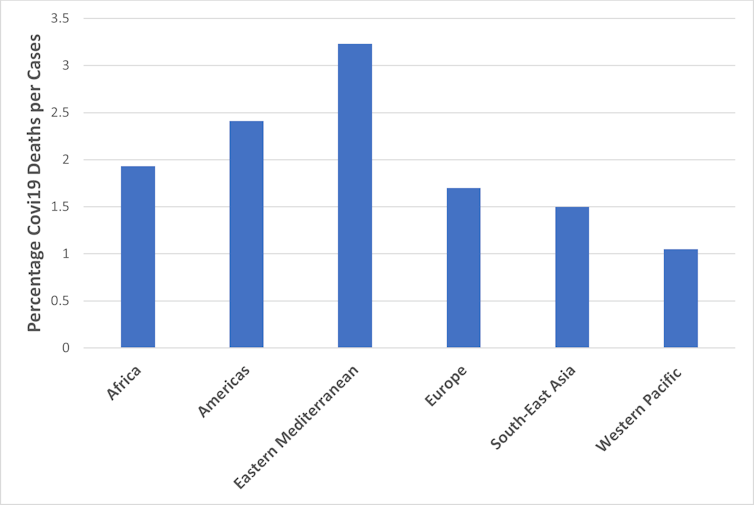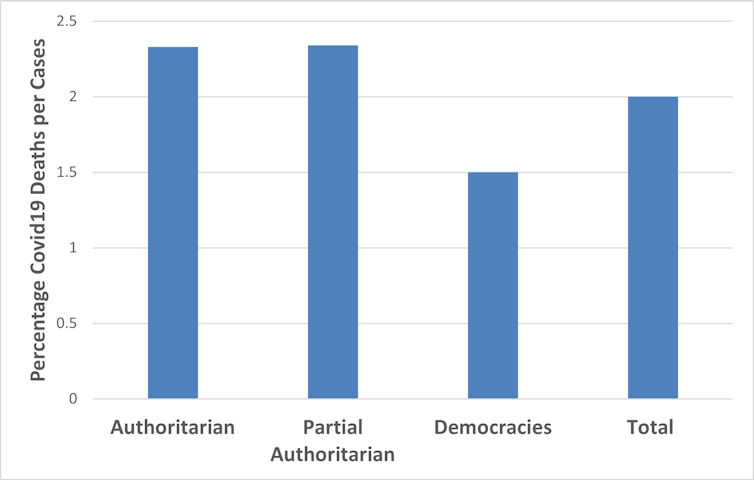COVID-19: how democracies have fared compared with authoritarian regimes
When Francis Fukuyama published his bestselling book, The End of History, in 1992, democracies were on the rise. Today, democracies across the world are declining in number, according to Freedom House, a think tank which tracks comparative regime changes over time. Fukuyama’s argument then was that liberal democracy had triumphed over the alternative Soviet model, because it provided efficient and accountable governance that delivered a prosperous economy, effective healthcare, education and welfare. In sharp contrast communism had failed.
COVID-19 has been the biggest challenge to the effectiveness of governments this century, and one argument that has been put forward, particularly by China, is that the one-party state model is more effective at dealing with the pandemic than are democracies. The assertion is that disagreements and confusions in democracies stand in the way of effective collective action and disturb “social harmony”. The success of the Chinese economy in recovering from the pandemic means this idea has to be taken seriously. But when it comes to the COVID crisis, is this argument actually true?
There are clearly many factors that will go into judging how successful different countries are in containing the pandemic, including lockdowns and quarantines. But a look at how countries categorised as democracies or authoritarian regimes performed in relation to death rates suggests further enquiry will be needed to answer the question. Death rates are not a simple measure, with different data sources, healthcare systems and variations in spending across countries complicating the picture. That said, the World Health Organisation has the most reliable data available on COVID deaths as a percentage of cases across the world.
Freedom House rates the state of democracy across the world by looking at factors such as freedom of speech, the existence of free and fair elections, the right to participate in politics and respect for the rule of law in more than 200 countries and territories across the world. In a recent report they classified all states and territories into three categories: “Not free”, “partially free” and “free”.
Altogether the report identified 54 authoritarian or “not free” states and territories including China and Russia – a number that has increased by nine since 2005. In addition, they classified 59 countries as semi-authoritarian or “partially free”, such as the Philippines, with one additional state joining this group since 2005. Finally, they classify 82 countries as democracies or “free”, a tally that has declined by seven over the 15-year period. The report gloomily concluded that “since it spread around the world in early 2020, COVID has exacerbated the global decline in freedom”.
Death rates
Some 20 months into the worldwide pandemic we can start to test the claim of the superiority of authoritarian regimes over democracies in managing it. WHO data on COVID death rates is one way to begin to judge how effective different states have been in dealing with the pandemic.
The WHO provides data on the cumulative number of cases and the total number of deaths in each state or territory since the start of the pandemic.
A useful measure of the performance on these states in handling the pandemic – and one used by researchers at Johns Hopkins University in the US – is the percentage of cases ending up in deaths. If a large proportion of the cases result in deaths, it suggests that a ccountry’s health service may be performing poorly in managing the pandemic.
To illustrate this using the US, the WHO data published on August 23, 2021 showed that it had a total of 11,301 cumulative cases and 188 deaths per 100,000 population, so the percentage of deaths per cases was 1.7%.
Again it is important to remember that many factors may explain variations in death rates across countries, reflecting geography, population density, standards of living, inequality, the quality of governance and the state of democracy.
COVID deaths by region (%), August 2021

The WHO categorises all countries and territories into six geographical regions and the figure above shows the death rates in each of them.
Clearly, South-East Asia and Western Pacific countries did best in when it came to controlling the death rates, the latter including China, which had a death rate of 4.7%, nearly three times larger than the US, although the region as a whole did better than the Americas.
Interestingly, Europe and South-East Asia had rather similar death rates in this respect. In contrast, the Eastern Mediterranean region stands out clearly as the worst of all. This region contains failed states such as Sudan as well as countries wracked by internal wars such as Syria and Iraq. Not surprisingly, war really weakens a state’s response to COVID-19. The worst case in that region and indeed in the world was Yemen, with percentage of deaths per cases reaching 19%.
These averages conceal large variations. In Africa, the Seychelles had a death rate of 0.5%, whereas in Zimbabwe it was 3.5%. Similarly, in the Americas, Cuba had a rate of 0.7% and so did very much better than Peru at just over 9%. The best performing territory in Europe was the Faroe Islands, in the North Atlantic, at 0.1% and the worst was Bosnia and Herzegovina with a rate of 4.7%. In Britain the rate was 2%.
COVID and democracy
But what of the relationship between performance in handling the pandemic and democracy? This appears in the graph below, which shows the average death rates using the Freedom House classification. The figure shows that democracies had significantly fewer deaths per 100,000 cases than authoritarian regimes such as China and semi-authoritarian regimes such as the Philippines.
COVID deaths by political category (%)

An obvious factor which could explain this is that democracies tend to be richer than authoritarian regimes and so they clearly have the resources to fight COVID that other states may lack. However, while there is a relationship between GDP or national income and the death rate, it’s rather weak. The correlation between these two measures was -0.16 across the world, indicating that national income has only a rather modest role in reducing death rates. Note that if a 1% increase in GDP produced a 1% decrease in the death rate the correlation would be -1.0, whereas the actual correlation was much weaker.
Further analysis is needed to explore the many other factors that might be at work in explaining state responsiveness to COVID. But it’s clear the argument that authoritarian states are superior to democratic states when it comes to dealing with the pandemic is not supported by these comparative death rates.
The complexities of the relationship between governance and the pandemic is highly complex and so we are starting a research project to examine this issue in more detail, looking at the comparative politics of COVID. But for now looking at the big picture certainly suggests that countries that have abandoned democracy over the years aren’t simply “better” dealing with the pandemic.![]()
Paul Whiteley, Professor, Department of Government, University of Essex
This article is republished from The Conversation under a Creative Commons license. Read the original article.


